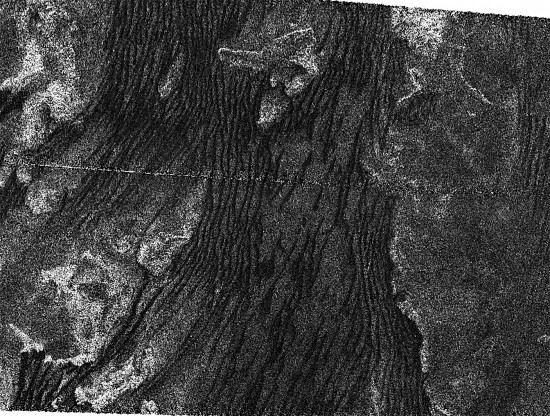
An area on Titan about 37,000 square kilometers. North is toward the top of the image, radar illumination is from the right. The stripe across the center is an artifact. Credit: NASA/JPL-Caltech/ASI.
Oct 2, 2015
Are dunes on Titan like those on Earth?
“To see a world in a grain of sand and a heaven in a wildflower, hold infinity in the palm of your hand and eternity in an hour.”
— William Blake
The Cassini spacecraft created a gravity map of Titan as the orbiter’s speed was measured by the Earth-based Deep Space Network. Titan’s gravity “pushed and pulled” Cassini in its flight path as it flew by the giant moon between February 2006 and July 2008. Data indicated that Titan’s interior is a mixture of rock and ice with no layering.
Since variations in gravity suggest variations in density, the subtlety of the measurements indicated that there are no “mascons” of rock distributed through Titan’s body as there are inside Earth’s Moon. Instead, the rocks and ice are thought to be compacted into a relatively homogeneous interior structure. If that is the case, then little variation in surface morphology would be expected, since no energy from the moon’s core contributes to mechanical changes. What explains the anomalous formations?
One of the most intriguing anomalies on Titan are the long, massive dune formations that cover an area equivalent to about half the size of Australia. Recently, planetary scientists from the University of Washington’s Virtual Planetary Laboratory announced that they might have an idea why the dunes are in a preferred east to west orientation.
The so-called dunes on Titan are large, well-defined, almost solid-looking waves that pass over craters and around what are referred to as “yardangs.” They appear to follow the prevailing wind patterns on Titan that blow a mere eight kilometers per hour. There are some unusual characteristics that might mean they are not wind-generated in the conventional sense, however.
According to the press release, “Violent methane storms high in Titan’s dense atmosphere, where winds do blow toward the east, might be the answer,” said Dr Benjamin Charnay.
Dune formations can be found in the Solar System on Earth, Mars, Venus, and Titan. On Earth, the average temperature ranges from between 15 and 17 Celsius, with an environment rich in liquid water. On Mars, the average temperature is minus 50 Celsius with no liquid water at all. On Venus, the average temperature is 460 Celsius: a scalded lava planet.
The surface temperature on Titan averages minus 180 Celsius. It is so cold that if water were present it would be rock-like and would not contribute to any chemistry. So, it might be asked, what force can create regular, evenly spaced piles, some hundreds of meters high, despite the disparity in environments?
On Earth, dunes are only in the driest places. Similarly with Mars. Sand and dust must slide freely over one another for dunes to accumulate and move across the landscape. Strong winds are usually required to move the sand. As written elsewhere, in Australia’s Simpson Desert sand dunes are fossilized and immobile, although they cover thousands of square kilometers. Whatever deposited the sand there did not move it again, so they crusted over, plants took root, and gullies formed.
Many of the dunes on Titan look like fingerprint patterns, with whorls and arches that are crisscrossed by other ripples in a perpendicular arrangement, looking almost exactly like the dune fields found along the coast of Namibia.
The popular press has published articles saying that Titan is “wet” with hydrocarbons so many times it is now stated as a fact, although when the Huygens probe landed on Titan, it sank slightly into a friable surface that NASA described as “like wet snow,” or “loose clay,” or “dry sand.” Huygens detected methane in the area but it quickly dissipated.
If Titan were wet, the winds that blow a mere eight kilometers per hour would not be able to accumulate material into long dunes: moisture would cause the dust to become sticky, while any larger grains would be mired in slush. With such minimal wind speeds recorded by the Huygens lander, it stands to reason that Titan is dry, despite claims that there are “lakes” of liquid ethane and “methane storm” speculations.
Since Titan is dry, with folded-rim craters that have wide, flat bottoms (often with more than one tier or concentric basin), parallel fractures, large domes similar to those on Venus, and Lichtenberg figures (called river channels by the Cassini team), then a better explanation for what happened to Saturn’s planet-sized moon might be found by considering Mars.
In an Electric Universe, dunes are associated with electric arcs. When electric discharges excavate material, it blows upward along the current path where it then falls away, forming what are called “wind streaks.” Particles can be attracted or repelled from one another, depending on their polarity. Therefore, they align themselves in the same way that iron filings align themselves with the magnetic field of a bar magnet. It is possible that that is the mechanism behind the dune structures on Titan, as well.
In the equatorial latitudes of Titan is a great “sand sea” called Belet. If, like Earth, Venus, and Mars it represents the fragments of rock strata that were destroyed by electric discharge activity and then ionically deposited, it is probably the source for the dunes and streaks of fine dust.
Stephen Smith












